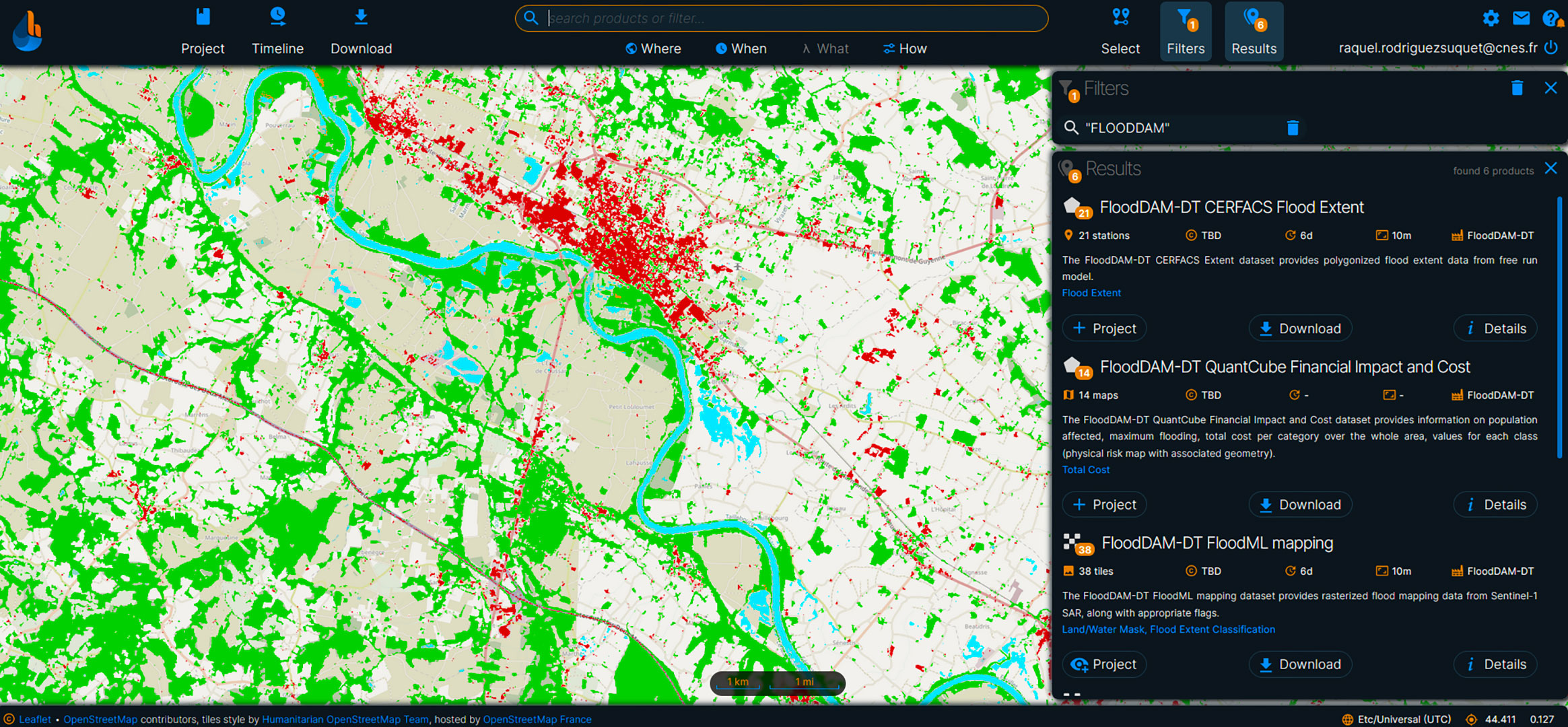FloodDAM-DT completes its flood risk digital twin prototype
December 10, 2024 press release
QuantCube Technology and French space agency, CNES, today announced the successful delivery of a sophisticated flood warning and risk mapping prototype, the SCO FloodDAM Digital Twin.
The prototype, which can detect, monitor, assess and predict the financial and socio-economic risks related to flood events, harnesses continental water data from earth observation data, in-situ ground sensors and drone data. This information is then processed by using state-of-the-art hydrological and hydrodynamic models to produce flood re-analysis and forecasts for different scenarios emerging from the digital twin.
The announcement is made on behalf of a consortium of organizations involved in the project, including leading partner space agencies, CNES and NASA. This international collaboration is supported by the Space for Climate Observatory (SCO) initiative—an international effort focused on the development of advanced climate monitoring, mitigation and adaptation tools. A total of nine organizations brought their expertise to the project, collaborating to deliver the following five capabilities:
- Flood detection and warning (USGS, VigiCrues, vorteX.io, JPL).
- Near real-time mapping of flood extent, and monitoring of ongoing flood events using Earth Observation imagery (CNES-CLS).
- Re-analysis and short-term forecasting of flood extent surfaces, water level, velocity and free-surface elevation maps using high-fidelity hydrodynamic models over local areas to analyse present conditions and provide forecasts for the affected region (CERFACS).
- Near real-time and post-event estimation of financial risk associated with floods (QuantCube Technology).
- On-demand processing of flood rapid mapping with visualizations of flood events available via the open national hydrological platform, hydroweb.next (CNES-CS Group).
The project focused on two sites for analysis—the Garonne Marmandaise catchment in France and the Ohio catchment in the United States—with the consortium harnessing standardized open-source software and data, as well as state-of-the-art modelling and data assimilation techniques to create the SCO FloodDAM-DT.
The prototype provides an estimation of the financial risk associated with flooding events in agricultural areas in the selected test areas. This information can then be used by governments and institutions, such as insurers, real estate funds, financial institutions, and other entities concerned with the physical risk associated with assets.
“Almost every day, terrible floods prove that the planet’s water cycle is increasingly susceptible to disruption. One of the first SCO-certified projects, FloodDam, has evolved into a digital twin, building on the processing chain originally developed to create an essential tool for flood risk prediction and impact assessment. This real technical and technological achievement is the fruit of a remarkable French-American collaboration, reminding us of the importance of cooperation in adapting to our changing world,” says Frédéric Bretar, head of the SCO program at CNES.
Thanh-Long Huyhn, co-founder and CEO, QuantCube Technology, says, “Through harnessing a combination of earth observation data, continental water data, in-situ remote sensing, and hydrological models, we have demonstrated that it is possible to produce large scale prediction and financial risk impact indicators for flood events on agriculture. The possible use cases for this kind of technology extends across industries and beyond, from trading and asset management to national governments and agencies, and it is our intention to fully explore these applications.”
Raquel Rodriguez Suquet, CNES, earth observation applications engineer says, “Thanks to the support of the Space for Climate Observatory alliance, the FloodDAM-DT project, jointly with the IDEAS (Integrated Digital Earth Analysis and System) project supported via NASA's Earth Science Technology Office by the Advanced Information Systems Technology (AIST) program, have proven what can be achieved through international collaboration and data sharing. The result is an Earth System Digital Twin (ESDT) that enables researchers, decision-makers and policymakers to visualize, analyse, and evaluate the impact of extreme environmental events on target regions.”
To learn more about:
👉 The IDEAS project from NASA/JPL
About CNES
CNES (Centre National d'Études Spatiales) is the public establishment responsible for proposing French space policy to the Government and implementing it in Europe. It designs and puts satellites in orbit and invents the space systems of tomorrow; it promotes the emergence of new services that are useful in everyday life. CNES, created in 1961, initiates major space projects, launchers and satellites and is the natural partner of industry for pushing innovation. CNES has nearly 2,400 employees, men and women who are passionate about space, which opens up infinite, innovative fields of application; it intervenes in five areas: the Ariane launcher, scientific research, observation, telecommunications and defence. CNES is a major player in technological innovation, economic development and industrial policy in France. It also establishes scientific partnerships and is involved in numerous international projects. France, represented by CNES, is one of the main contributors to the European Space Agency (ESA).
Learn more at: www.cnes.fr
About QuantCube
QuantCube Technology uses artificial intelligence and big data analytics to deliver real-time macro-economic insights. The firm operates one of the largest alternative data lakes in the world, processing more than 14 billion data end points. Sources encompass news, social media, satellite data, professional networks and consumer reviews, as well as international trade, shipping, real-estate, hospitality and telecoms data.
QuantCube’s macro nowcast indices, on variables including economic growth, inflation, employment and international trade, correlate highly with official data and significantly beat the consensus. Financial institutions using QuantCube data benefit from real-time insight, often ahead of official numbers, which they can use to inform their investment strategies.
Headquartered in Paris, QuantCube employs a diverse international team of data scientists with expertise in multilingual NLP, deep learning and machine learning techniques. The company’s shareholders include Moody’s and Caisse des Dépôts and its R&D in computer vision has been partially funded by the European Space Agency (ESA) and French government space agency CNES.
Learn more at: www.quant-cube.com



